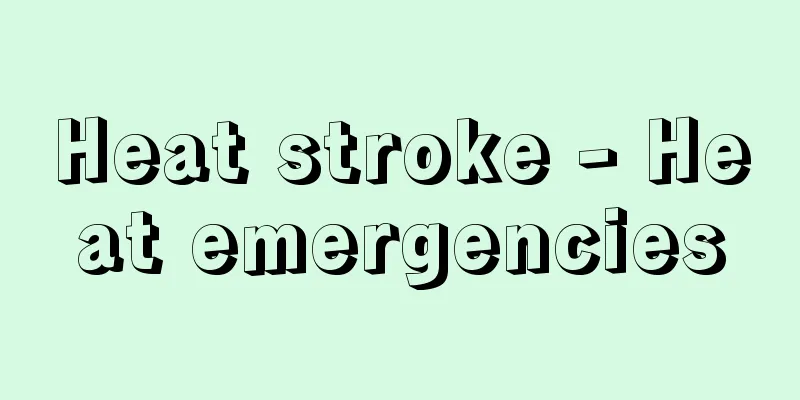Heat stroke - Heat emergencies

What kind of disability is it? Heatstroke is a general term for physical disorders caused by exercise or heat. Medically speaking, heat stroke is What is the cause?The human body lowers its temperature by losing heat through the skin and by sweating, but when the outside air is above skin temperature or when the humidity is very high, it becomes difficult to lose heat or sweat, which can lead to heatstroke. Elderly people with underlying diseases, obese people, people with diabetes, and people with alcoholism are more likely to suffer from heat stroke. There have been reports of many elderly people suffering from heat stroke in years when there was an abnormal heat wave. On the other hand, there is a theory that the most severe form of heatstroke, which can be fatal, is related to predisposing factors (original constitution). The reasoning is that heat stroke can occur even with thorough training and management thanks to advances in sports medicine, and that heat stroke is very similar in pathology to malignant hyperthermia, an abnormally high body temperature caused by anesthesia. How symptoms manifest Heat stroke can be classified into mild heat cramps and moderate heat stroke. Symptoms range from headaches and fatigue to what is commonly known as "heatstroke," heat cramps that cause muscle cramps, heat exhaustion that is mainly caused by dehydration and leads to headaches and nausea, and the most severe form of heat stroke, in which the body temperature exceeds 40°C and consciousness is lost. Treatment methods1. Heat convulsions This is likely to occur when excessive sweating is caused by only replacing fluids, and is believed to be due to a relative lack of salt. For this reason, saline or lactated Ringer's solution is administered intravenously. ②Heat exhaustion Although this is a type of dehydration, because the body's thermoregulatory function remains, sweating continues and the body temperature does not rise significantly. Intravenous infusion of saline or lactated Ringer's solution and administration of analgesics are effective, but since correcting dehydration takes time, treatment is required after hospitalization. 3) Heat stroke The function of the body temperature center in the hypothalamus and sweat glands declines, causing the core body temperature to rise above 40°C, creating a highly urgent condition. Hematologically, consumption coagulation disorder (clotting factors are consumed, resulting in bleeding tendency) is observed, and even in survivors, The patient was admitted to the intensive care unit and given 1) cooling, 2) fluid and electrolyte adjustment, 3) anticonvulsants, How to provide first aidThere are three basic steps: 1) Rest Loosen your clothing and rest to help cool your body. ② Cooling Let it rest in a cool place. Move it to a shady, air-conditioned room with good ventilation. Also, 3) Hydration If the person is conscious, rehydrate them (with a sports drink). If they are unconscious or nauseous, they will need to be given fluids at a medical institution and an ambulance will be called to transport them to an emergency medical facility. Toshiharu Yoshioka Source: Houken “Sixth Edition Family Medicine Encyclopedia” Information about the Sixth Edition Family Medicine Encyclopedia |
どんな障害か 熱中症は、運動や暑熱から起こる体の障害の総称です。 医学的にいう熱射病は、 原因は何か人間の体は、皮膚からの放熱や発汗によって体温を下げますが、外気が皮膚温以上の時や湿度が非常に高いと、放熱や発汗ができにくくなり、熱中症を引き起こします。 基礎疾患のある高齢者や肥満、糖尿病の患者さん、アルコール依存症の患者さんは、熱射病に陥りやすいとされています。異常な熱波に見舞われた年に多くの高齢者に発生したという報告や、 一方、死に至ることもある最重症の熱射病には、素因(もともとの体質)が関係するとする考え方があります。 その論拠は、スポーツ医学の発達で指導管理を徹底しても熱射病が発症すること、また熱射病は、麻酔により異常な高体温となる悪性高熱症と、その病態がよく似ていることにあります。悪性高熱症は、骨格筋の 症状の現れ方 熱中症は、軽症の熱けいれん、中等症の 症状は、頭痛や疲労感を主とすることから、俗に「暑気あたり」といわれる状態や、筋肉がこむら返りを起こす熱けいれん、脱水が主体で頭痛や吐き気をもよおす熱疲労、体温が40℃を超え、意識がなくなる最重症の熱射病までさまざまです。 治療の方法①熱けいれん 大量の発汗に対し、水分のみを補給した際に起こりやすく、相対的な塩分の不足が原因とされています。そのため、生理的食塩水や乳酸加リンゲル液の点滴静注を行います。 ②熱疲労 脱水症の一種ですが、体温調節機能が残されているため、発汗は持続し、体温もそれほど上昇していません。生理的食塩水や乳酸加リンゲル液の点滴静注と鎮痛薬の投与で効果がありますが、脱水の補正に時間がかかるため、入院のうえ治療を行います。 ③熱射病 視床下部の体温中枢や汗腺の機能が衰退して深部体温は40℃以上になり、緊急性の高い状態です。 血液学的には消費性凝固障害(凝固因子が消費され、出血傾向が出現する)を認め、生存例でも高率に 集中治療室に収容し、①身体冷却、②体液・電解質の補正、③抗けいれん薬、 応急処置はどうするか基本は以下の3つです。 ①休息 体を冷却しやすいように衣服をゆるめ、安静にします。 ②冷却 涼しい場所で休ませます。風通しのよい日陰、クーラーの効いた部屋に移動します。 また、 ③水分補給 意識がはっきりしていれば、水分補給(スポーツドリンク)を行います。意識障害や吐き気がある場合は、医療機関での輸液が必要で、救急車を呼んで至急医療施設へ搬送します。 吉岡 敏治 出典 法研「六訂版 家庭医学大全科」六訂版 家庭医学大全科について 情報 |
<<: Thermoelectric thermometer
Recommend
Pessanha, C.de A. (English spelling) PessanhaCdeA
…Given its small population and narrow territory,...
Ashida Enosuke
A Japanese language educator active in the Taisho...
Stage - Okibutai
〘noun〙① A stage that is laid out on the Bugaku sta...
Asian Games
This sporting event was created after the Second ...
Sow thistle
...The pappus is sometimes used as cotton for ver...
Acidanthera bicolor - Acidanthera bicolor
...There are about 20 species in Ethiopia, Tanzan...
Bolometer
A type of resistance thermometer used to measure r...
Fauni
…Fauna, the goddess who has the same function as ...
Beroe cucumis - Beroe cucumis
A ctenophore of the Cucurbitidae family of the cla...
Herrera, Juan Bautista de
[Born] 1530. Movelan Died in 1597. Madrid. Spanish...
Leptoptilos dubius (English spelling) Leptoptilosdubius
… [Hiroyuki Morioka]. … *Some of the terminology ...
Incurable disease - Nanbyo
It is a general term for intractable diseases of ...
Suribotoke - Suribotoke
A type of Buddhist print, in which images of Budd...
Japanese cypress - Japanese cypress
…It is also used more as a garden tree and hedge ...
Caulerpa racemosa (English name) Caulerparacemosa
…[Mitsuo Chihara]. . . *Some of the terminology t...









